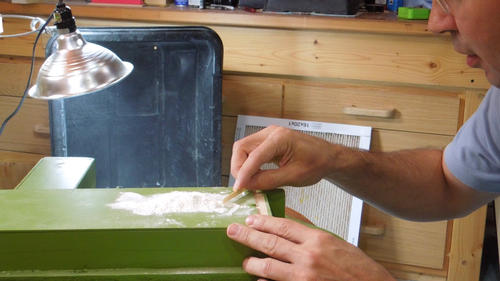 Iset up a black recycling bin and a bright light in front of the fan outlet
to better see the flour coming out of the fan.
Iset up a black recycling bin and a bright light in front of the fan outlet
to better see the flour coming out of the fan.
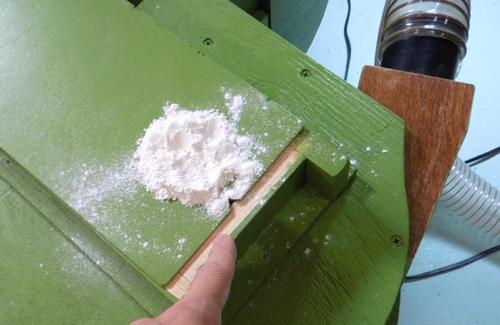
 I was curious how good the filter I used actually was. So I made a small notch opening
in the channel between my separator and the filter box so I could
push some flour into the air stream just upstream of the filter.
I was curious how good the filter I used actually was. So I made a small notch opening
in the channel between my separator and the filter box so I could
push some flour into the air stream just upstream of the filter.
I could see some flour dust coming out of the fan, so the filter wasn't catching all of it.
 Iset up a black recycling bin and a bright light in front of the fan outlet
to better see the flour coming out of the fan.
Iset up a black recycling bin and a bright light in front of the fan outlet
to better see the flour coming out of the fan.
For comparison, I re-ran the test without the filter. Pushing just a bit of flour into the hole resulted in a cloud of flour coming out of the fan. The photo at left was taken without the filter. So the filter wasn't perfect, but it was still catching most of the flour.
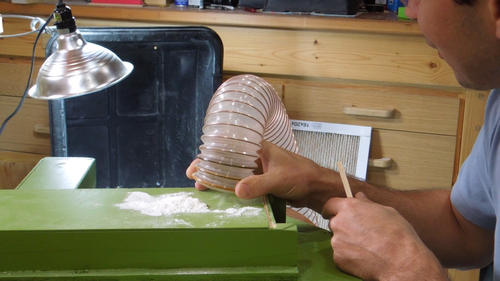 Still without a filter, I next sucked the bulk of the flour into the hose connected
to the separator. This resulted in very small amounts of flour coming out
of the fan. So by the looks of it, my separator is capable of separating fine
flour from the air. In fact, it does so much better than the "Airborne microparticle
reduction filter".
Still without a filter, I next sucked the bulk of the flour into the hose connected
to the separator. This resulted in very small amounts of flour coming out
of the fan. So by the looks of it, my separator is capable of separating fine
flour from the air. In fact, it does so much better than the "Airborne microparticle
reduction filter".
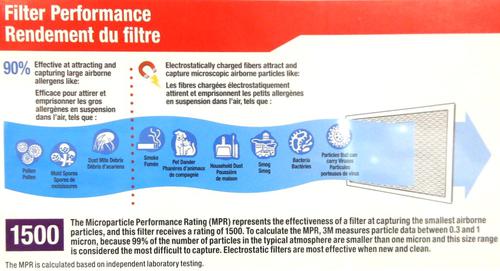 That filter has a microparticle performance rating (MPR)
of 1500 and is supposed to be able to catch microparticles in the 0.3 to 1
micron range. But it only claims to be 90% effective at catching the much
larger household dust particles, and the "99%" in the text is not about
anything relating to the filter's performance.
For all I know, the MPR rating of 1500 might just mean that it will catch
one in 1500 microparticles.
That filter has a microparticle performance rating (MPR)
of 1500 and is supposed to be able to catch microparticles in the 0.3 to 1
micron range. But it only claims to be 90% effective at catching the much
larger household dust particles, and the "99%" in the text is not about
anything relating to the filter's performance.
For all I know, the MPR rating of 1500 might just mean that it will catch
one in 1500 microparticles.
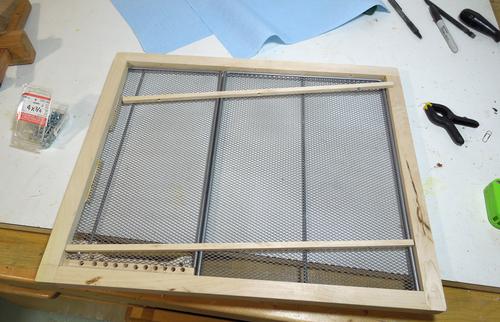 With the less than stellar performance of the filter, I experimented with
building my own filter. I built a wooden frame, with some metal screen
in the middle.
With the less than stellar performance of the filter, I experimented with
building my own filter. I built a wooden frame, with some metal screen
in the middle.
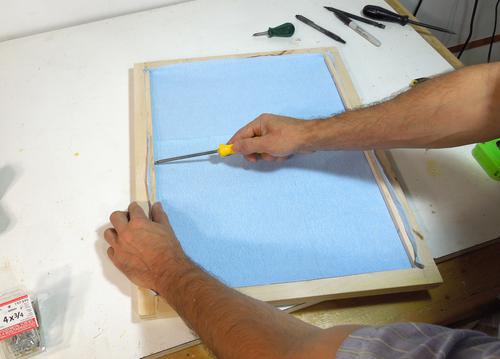 I then attached some disposable blue shop towel into the frame. The shop towel is only
held on two sides. Air pressure presses it against the frame and makes for a tight seal
around the other edges.
I then attached some disposable blue shop towel into the frame. The shop towel is only
held on two sides. Air pressure presses it against the frame and makes for a tight seal
around the other edges.
I found the shop towel filtered nearly as well as the furnace filter, but I got a 15 mm pressure drop across it, whereas with the furnace filter, the pressure difference was too small to get a good reading (maybe 2 mm). I imagine if I had been able to pleat the shop towel like the furnace filter, the extra area would have gotten it close enough not to matter. But I switched back to the furnace filter for the time being. If I was starting over, I'd probably design an enclosure to accommodate a larger area of shop towel instead of the relatively expensive furnace filter.
As it turned out, compared to the effective air resistance of my cyclone separator, the shop towel filter's air resistance was relatively insignificant.
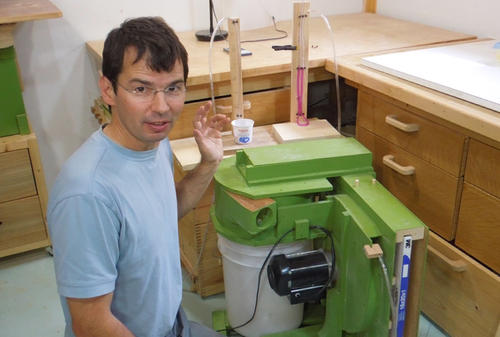 Feeding a hose into the open cyclone inlet, I measured vacuum readings inside the cyclone
from about 75 mm right after the jet to about 190 mm towards the middle of the cyclone.
The vacuum at the filter was only 185 mm.
I was actually reading greater vacuum inside parts of the cyclone than downstream
of it at the filter, although some of that suction may have been enhanced
by the Venturi effect.
The vacuum just ahead of my injector jet was 50 mm, and just past it was 75 mm, so the
injector constriction accounts for about 25 mm pressure drop. The vacuum in the bucket
was 50 mm. But the biggest pressure drop was the 75 mm from the nozzle to the
190 mm at the filter, the bulk of which is from centrifugal force in the cyclone.
Feeding a hose into the open cyclone inlet, I measured vacuum readings inside the cyclone
from about 75 mm right after the jet to about 190 mm towards the middle of the cyclone.
The vacuum at the filter was only 185 mm.
I was actually reading greater vacuum inside parts of the cyclone than downstream
of it at the filter, although some of that suction may have been enhanced
by the Venturi effect.
The vacuum just ahead of my injector jet was 50 mm, and just past it was 75 mm, so the
injector constriction accounts for about 25 mm pressure drop. The vacuum in the bucket
was 50 mm. But the biggest pressure drop was the 75 mm from the nozzle to the
190 mm at the filter, the bulk of which is from centrifugal force in the cyclone.
When I attached my hose (2.5" diameter), the vacuum where the hose connects to the dust extractor read at 50 mm. So my injector nozzle only adds about half as much pressure drop as the hose.
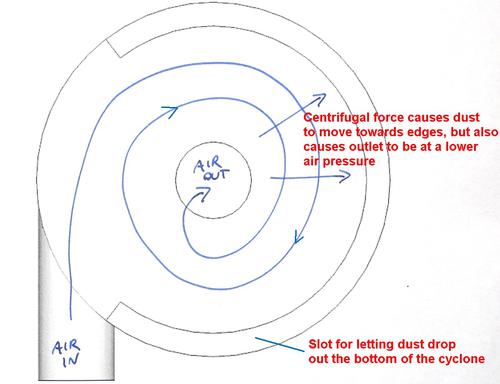 It may seem a bit counterintuitive that the cyclone, with relatively large openings
on either end, should introduce this much air resistance. But the cyclone, with air
spinning rapidly inside it, is like pushing air backwards through a blower.
As the air spirals
inwards, its angular momentum is conserved. So like a figure skater pulling in her
arms, the air increases its rotational speed as it moves to the middle.
A similar effect also causes the increase in air speed
in a tornado
It may seem a bit counterintuitive that the cyclone, with relatively large openings
on either end, should introduce this much air resistance. But the cyclone, with air
spinning rapidly inside it, is like pushing air backwards through a blower.
As the air spirals
inwards, its angular momentum is conserved. So like a figure skater pulling in her
arms, the air increases its rotational speed as it moves to the middle.
A similar effect also causes the increase in air speed
in a tornado
All that rotation makes for a large amount of centrifugal force. The centrifugal force in turn causes the dust to separate out from the air. But that same centrifugal force also acts on the air, resulting in a pressure drop.
The pressure drop is enough to reduce the flow rate from my fan by about 40% from what it was unobstructed.
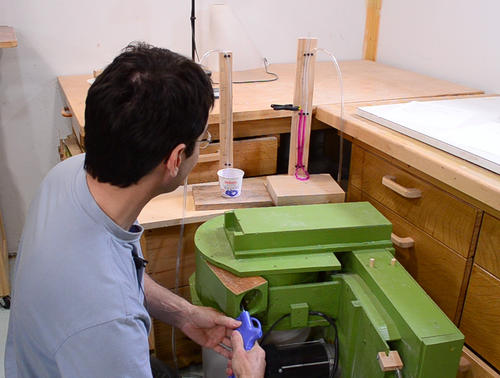 If most of the air resistance of my separator is the result of back pressure
from centrifugal force, then speeding up the rotation by injecting air
into the cyclone with a compressor would cause more centrifugal force,
potentially causing enough additional back pressure to actually reduce
airflow. I tested that theory by sticking the air compressor nozzle into
the inlet and blowing. And sure enough, when I did that, the airflow
coming out of the fan actually decreased!
If most of the air resistance of my separator is the result of back pressure
from centrifugal force, then speeding up the rotation by injecting air
into the cyclone with a compressor would cause more centrifugal force,
potentially causing enough additional back pressure to actually reduce
airflow. I tested that theory by sticking the air compressor nozzle into
the inlet and blowing. And sure enough, when I did that, the airflow
coming out of the fan actually decreased!
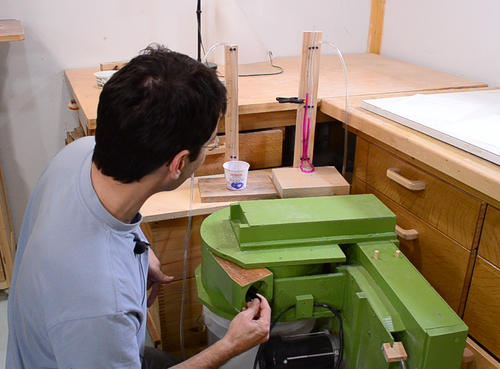
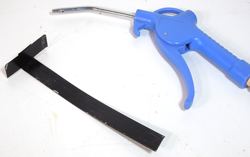 If speeding up the cyclone reduces airflow, slowing it down should
therefore increase it.
So I made a sort of "hook" to slide into the inlet, which would slow
down the air as it shot into the chamber from the inlet.
Pushing this hook into the cyclone, just past the inlet jet,
actually did increase the airflow.
If speeding up the cyclone reduces airflow, slowing it down should
therefore increase it.
So I made a sort of "hook" to slide into the inlet, which would slow
down the air as it shot into the chamber from the inlet.
Pushing this hook into the cyclone, just past the inlet jet,
actually did increase the airflow.
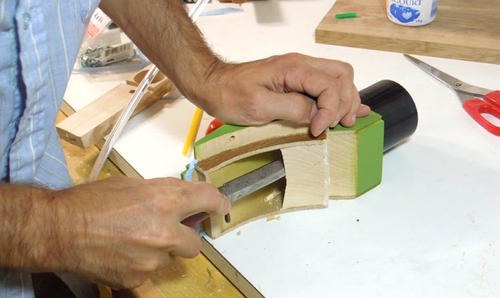 I wasn't about to deliberately put an obstruction into the cyclone, because
that would cause more turbulence and probably reduce it's effectiveness
at separating dust.
But I figured slightly widening the injector jet wouldn't hurt. A wider opening
means the inlet makes a wider, slower jet of air. It would also slightly reduce
the air resistance of the injector. Widening the jet made only
a small difference overall, and my separator is still able to separate
folour from air.
I wasn't about to deliberately put an obstruction into the cyclone, because
that would cause more turbulence and probably reduce it's effectiveness
at separating dust.
But I figured slightly widening the injector jet wouldn't hurt. A wider opening
means the inlet makes a wider, slower jet of air. It would also slightly reduce
the air resistance of the injector. Widening the jet made only
a small difference overall, and my separator is still able to separate
folour from air.
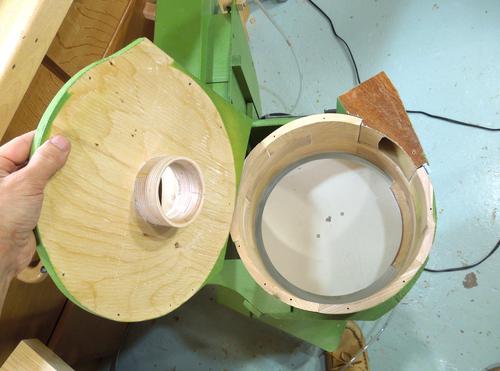 I figured if I had a slightly bigger outlet at the top of the separator,
the air wouldn't have to spin quite as tightly at the end, so that might also
reduce the reverse pressure. So I made a slightly bigger hole in the top.
I figured if I had a slightly bigger outlet at the top of the separator,
the air wouldn't have to spin quite as tightly at the end, so that might also
reduce the reverse pressure. So I made a slightly bigger hole in the top.
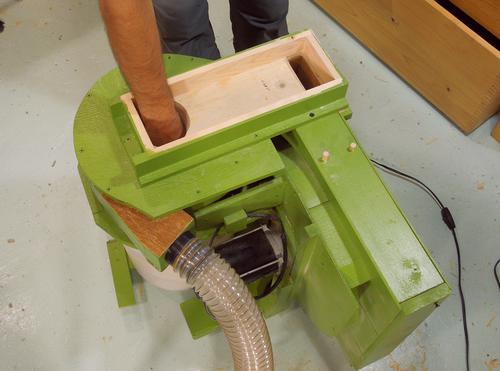 More importantly, the new opening is just large enough that I can reach
into it with my hand, just in case something gets plugged up inside.
More importantly, the new opening is just large enough that I can reach
into it with my hand, just in case something gets plugged up inside.
Out of curiosity, I had earlier thrown the 25 mm marble into the separator to see how fast it would spin around. Turns out it didn't spin around at all, but being too large to fall through the gap around the edge, and me unable to reach my hand into the box, I had the hardest time getting it back out.
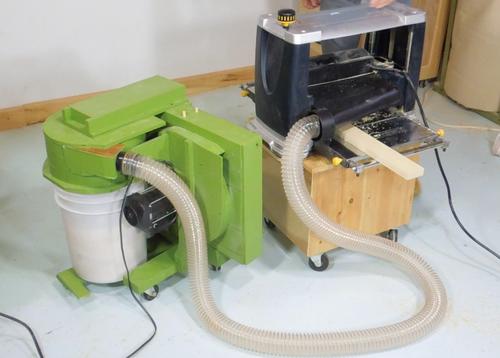 This separator really isn't meant to work with a planer, but out of curiosity,
I tried it anyway. It doesn't quite have enough airflow to reliably keep
up with wide stock through my thickness planer.
The really wide shavings can jam inside the manifold of the planer.
But then again, the planer's manifold is probably not a very good design.
I guess that would be a minor advantage of one of those fancy spiral cutter heads
with individual carbide cutters. The shavings are only as wide as the individual
carbide cutters. But one of those carbide cutter heads would cost much more
than what I paid for this planer.
This separator really isn't meant to work with a planer, but out of curiosity,
I tried it anyway. It doesn't quite have enough airflow to reliably keep
up with wide stock through my thickness planer.
The really wide shavings can jam inside the manifold of the planer.
But then again, the planer's manifold is probably not a very good design.
I guess that would be a minor advantage of one of those fancy spiral cutter heads
with individual carbide cutters. The shavings are only as wide as the individual
carbide cutters. But one of those carbide cutter heads would cost much more
than what I paid for this planer.
Some of the longer planer shavings can also get caught in the end of the curved slot between the cyclone and the bucket. But I guess this edge that stuff can get caught on is an inherent weakness to Thien-baffle type cyclones.
 I have been sucking up some of the debris off my shop floor with it, and for small
pieces of wood, it works ok.
I have been sucking up some of the debris off my shop floor with it, and for small
pieces of wood, it works ok.
Overall though, I'm pretty sure a traditional cyclone, with a cone on the bottom, makes for a better separator. I think there's less risk of one of those getting plugged up, and I'm also pretty sure they do better in terms of how much pressure drop they need vs particle size of dust they can separate. But if space, especially vertical space, is limited, the Thien-baffle type cyclone is the way to go.
Regardless of design, for any cyclone, there is going to be significant amount of pressure drop, and, depending on the size of your filter, more pressure drop than from the filters. So having a large filter bag, where dust can fall straight from the filter into the collection bag is actually quite smart. When the filter bag deflates, that's a bit like shaking it out, allowing dust to fall down. Maybe that's why most bag type dust collectors don't have a cyclone on them.
I designed this separator to maximize the rotation and centrifugal force. I would imagine most Thien-baffles would have less extreme circular motion of the air, and correspondingly, less pressure drop. The pressure drop has more effect on this dust collector than it would with a shopvac. The fan in my dust collector produces relatively little vacuum, my filter has very low air resistance, and I was testing without hoses (which also add a lot of air resistance). So the cyclone accounts for most if the air resistance in my test. When used with a shopvac, which will produce about 4-5x as much vacuum, and with a small filter that already has a very high air resistance, the relative pressure drop of a cyclone or Thien-baffle will have a relatively smaller effect on airflow.
More thoughts on dust collection - an email exchange with Phil Thien, inventor of the thien baffle
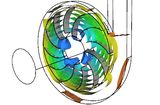 Computational fluid dynamics analysis of a small dust collector
Computational fluid dynamics analysis of a small dust collector